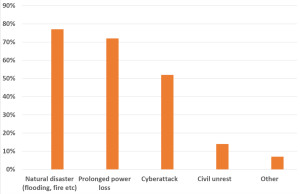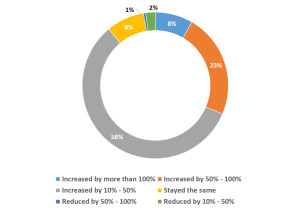“Businesses sometimes think that because their storage is running smoothly, they don’t have to worry about planning for a disaster recovery situation,” warns O’Connor. “This isn’t sensible practice. Back-up and storage should be designed side-by-side and implemented as a unified solution. Storage, back-up and recovery should all be interlinked and working in tandem. Regular testing is an essential part of any storage and back-up solution.”
“In addition, 30% said they carry out tests once a year, and a further 9% said that they carry out tests every two years or more. In our experience, DR tests should be conducted once a quarter or bi-annually. The solutions we have facilitate DR tests without interrupting the live environment. This way you can be sure the data is consistent and the DR solution is working.”
On the subject of disaster planning, the most common disasters taken into account were natural disasters such as fire, flood etc. which was selected by 77%, with prolonged power loss selected by 72%, and cyberattack listed by 52%. Civil unrest was next as selected by 14%, with other selected by 7%. Under the other category, pandemics and theft were conditions of note. Again, this was of no great surprise to O’Connor, but concerns were raised on one point.
“Just 52% plan for a cyberattack. With the frequency and potency of cyberattacks increasing all the time, Irish organisations need to be fully prepared if it happens to them. It’s important to implement a comprehensive security strategy that incorporates solutions such as unified threat management (UTM), End User Protection and Mobile Security. These solutions need to be built into an organisation’s overall IT infrastructure. Make sure that security and disaster recovery are considered together, and there are no weak points in your organisation’s defence. The potential risks and costs associated with cybercrime are too big. Always be prepared,” said O’Connor.
Respondents were asked about disaster recovery documentation, with 22% reporting that such materials were kept onsite, 7% saying offsite, and 36% saying both. However, more than a third (35%) said that there was no such documentation.
“This beggars belief,” O’Connor declares. “Every disaster recovery solution needs to have clear and documented processes written and agreed as part of an overall disaster recovery solution.”
“Standard best practice is to prepare documentation in advance, in full agreement of all parties, and stored onsite and offsite. Yet only 36% of companies do this according to the survey. This needs to change. Our recommendation would be to get your disaster recovery partner to draw up and maintain a full set of SLAs, including RTO, Recovery Point Objectives (RPO) and all necessary actions and who is responsible for each.”
Addressing the issue of data volume, respondents were asked about changes over the past 12 months. Just 8% said volumes had stayed the same, with a collective 3% noting any significant reduction. More than half (58%) said that there was an increase of 10-50%, with nearly a quarter (23%) noting a 50-100% increase. A significant 8% said that it had increased by more than 100%, all confirming that few organisations are immune to the growing volume of data.
“The average increase in the volume of data stored in the past 12 months across all organisations surveyed is 42%,” notes O’Connor. “This is a huge level of growth and it shows no signs of slowing. More and more organisations will struggle to manage their rapidly growing storage, back-up and recovery requirements. With the continued rise of mobile devices and personal storage options too, it really can be a minefield for most organisations. Many IT departments are spending more and more time trying to manage this data explosion, while they should be devoting their time to more value-add initiatives. That’s why we recommend that organisations should talk to business continuity specialists and managed service providers who have all the accreditations and expertise needed to look after this growing problem.”
In dealing with this issue, 64% of respondents said that they had the storage capacity to meet the growing needs by adding additional disks, while 26% said their needs would be met by scaling out to virtual private cloud. A significant 7% indicated they would meet the needs by scaling out to public cloud, while 4% said that their current storage infrastructure was already at capacity.
With regard to mission critical data specifically, respondents were asked for expected recovery times. Just one in 10 expected a sub one hour recovery time, with a quarter indicating 2-4 hours and almost the same (24%) indicating 4-12 hours. Some 18% reckoned that their critical data recovery time would be 12-24 hours, with 19% estimating anywhere from 1-5 days. Somewhat reassuringly only 2% indicated a 5-30 day recovery time but 3% responded with 30 days or more.









Subscribers 0
Fans 0
Followers 0
Followers